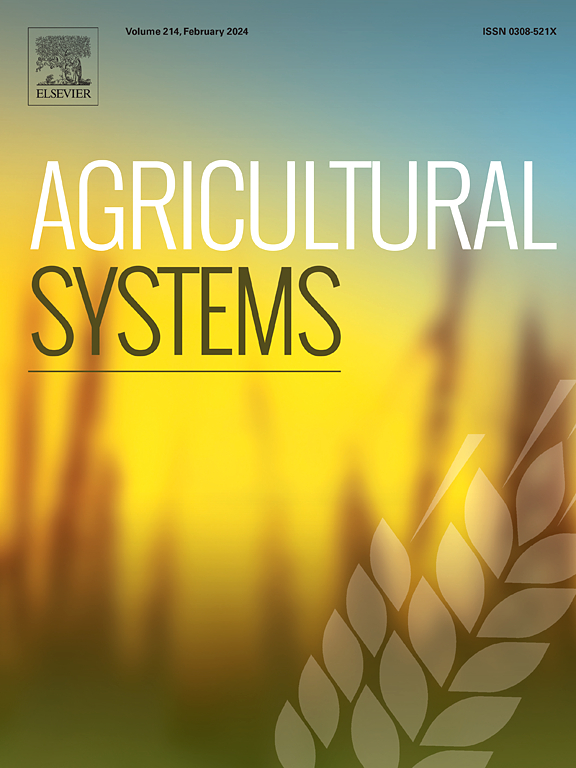基于web的橄榄园土地适宜性评价多标准空间决策支持系统(MC-SDSS)意大利南部卡拉布里亚地区的案例研究
IF 6.1
1区 农林科学
Q1 AGRICULTURE, MULTIDISCIPLINARY
引用次数: 0
摘要
有效和可持续的农业用地管理对发展农业和粮食生产至关重要。橄榄树是地中海地区最重要的栽培植物之一。然而,它们特别容易受到气候和社会经济变化的影响,这些变化正在区域和全球范围内迅速改变农业生态系统。目的:本研究介绍了一个基于网络的多标准空间决策支持系统(MC-SDSS)的实施结果,该系统专门用于评估橄榄种植土地的适宜性。目的是确定最适合可持续橄榄种植的地区。方法本系统基于免费开源的地理空间软件(FOSS4G)。通过对卡拉布里亚地区(意大利南部)的橄榄种植进行LSE测试,实现了网络平台(WebGIS橄榄适宜性)。该平台旨在管理具有不同访问级别(即用户权限)的用户:Guest(数据可视化),Expert(进行评估)和Decision-Maker(做出最终决策)。决策者收集每个专家给出的评价结果,通过几何平均将所有中间结果汇总,生成最终的适宜性图,该适宜性图代表了所有专家提供的评价的综合。结果与结论最终的适宜性评价确定了橄榄可持续种植的最适宜区域。结果表明,卡拉布里亚省适宜橄榄可持续种植的总面积为109,595.10 ha,其中橄榄园已占46,912.17 ha。该工具旨在支持需要多时间和多参与者方法的更复杂的规划过程。这些方法对于从环境和景观的角度评估不同的替代方案和提出各种可持续的解决方案至关重要。本文章由计算机程序翻译,如有差异,请以英文原文为准。

Web-based multicriteria spatial decision support system (MC-SDSS) for land suitability evaluation in olive groves. A case study in Calabria region, southern Italy
CONTEXT
Effective and sustainable agricultural land management is essential for developing agriculture and food production. Olive trees are among the most significant cultivated plants in the Mediterranean region. Yet, they are especially vulnerable to climatic and socioeconomic changes rapidly transforming agroecosystems at a regional and global scale.
OBJECTIVES
This study presents the outcomes of implementing a web-based multi-criteria spatial decision support system (MC-SDSS) designed explicitly for evaluating land suitability for olive cultivation. The aim is to identify areas that are most suitable for sustainable olive growing.
METHODS
This system relies on free and open-source geospatial software (FOSS4G). The implemented web platform (WebGIS Suitability Olive) was tested by performing an LSE for olive growing in the Calabria region (Southern Italy). The platform is designed to manage users with different levels of access (i.e., user's privileges): Guest (data visualization), Expert (making evaluations), and Decision-Maker (making final decisions). The decision-maker collects the results produced by each expert, aggregating all the intermediate results through a geometric mean and generating the final Suitability Map, which represents the synthesis of all the evaluations provided by the experts.
RESULTS AND CONCLUSIONS
The final suitability assessment identifies the most appropriate areas for sustainable olive cultivation. The results indicate that the total area suitable for sustainable olive growing in Calabria is 109,595.10 ha, of which olive groves already occupy 46,912.17 ha.
SIGNIFICANCE
This tool is designed to support more complex planning processes that require multi-temporal and multi-actor approaches. These approaches are essential for evaluating different alternatives and proposing various sustainable solutions from environmental and landscape perspectives.
求助全文
通过发布文献求助,成功后即可免费获取论文全文。
去求助
来源期刊

Agricultural Systems
农林科学-农业综合
CiteScore
13.30
自引率
7.60%
发文量
174
审稿时长
30 days
期刊介绍:
Agricultural Systems is an international journal that deals with interactions - among the components of agricultural systems, among hierarchical levels of agricultural systems, between agricultural and other land use systems, and between agricultural systems and their natural, social and economic environments.
The scope includes the development and application of systems analysis methodologies in the following areas:
Systems approaches in the sustainable intensification of agriculture; pathways for sustainable intensification; crop-livestock integration; farm-level resource allocation; quantification of benefits and trade-offs at farm to landscape levels; integrative, participatory and dynamic modelling approaches for qualitative and quantitative assessments of agricultural systems and decision making;
The interactions between agricultural and non-agricultural landscapes; the multiple services of agricultural systems; food security and the environment;
Global change and adaptation science; transformational adaptations as driven by changes in climate, policy, values and attitudes influencing the design of farming systems;
Development and application of farming systems design tools and methods for impact, scenario and case study analysis; managing the complexities of dynamic agricultural systems; innovation systems and multi stakeholder arrangements that support or promote change and (or) inform policy decisions.
 求助内容:
求助内容: 应助结果提醒方式:
应助结果提醒方式:


